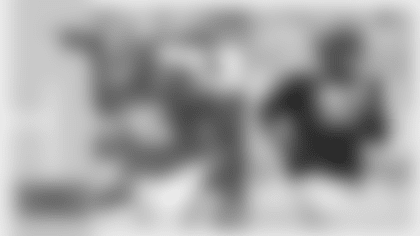GREEN BAY—If the read-option had come into vogue when he was playing, former Packers defensive end Kabeer Gbaja-Biamila says he would have enjoyed the challenge.
He believes he could have been pretty good at defending it, too.
"I would like to think I was an option specialist," said Gbaja-Biamila, who faced several option offenses in college at San Diego State. "I loved it. I liked playing against it."
"KGB," as he came to be known, will be one of three inductees into the Packers Hall of Fame on Saturday, July 20. Former kicker Chris Jacke and the late Emil Fischer, a former team president and board chairman, are joining Gbaja-Biamila as the newest Hall members.
Tickets remain available for the 43rd annual induction ceremony and banquet for $135 each, or $1,300 for a table of 10. Doors open at 4:30 p.m. with a cash bar, with the dinner and program to follow at 7 p.m. To purchase tickets, call Gwen Borga at (920) 965-6984, or e-mail her at gwenb@packershalloffame.com.
Gbaja-Biamila played nine seasons (2000-08) for the Packers and finished as the club's all-time leader in sacks (since the statistic became official in 1982) with 74 ½. Undersized for a typical defensive end, he used speed off the edge as his primary asset, and it's why he was so effective defending the option in college.
Granted, offenses like Air Force's are a far cry from the problems quarterbacks like Colin Kaepernick and Robert Griffin III present, but Gbaja-Biamila believes some of his college training would have carried over if he had faced the read-option in the NFL.
"The technique I was taught was the slow read," he said. "You wouldn't want to attack the quarterback. The end would basically slow play it, and you'd force the quarterback to make a decision. You'd sit at the line, because he's waiting for you to make a decision."
Gbaja-Biamila was fast enough to sack Michael Vick once and Kordell Stewart twice in his career, and that's the kind of speed needed against today's new-age QBs. The problem, Gbaja-Biamila said, is the discipline and patience the read-option requires, and the league's current lack of familiarity with the scheme, though that is steadily changing.
"It's unusual in the pros. They're not used to that," he said. "With the option, you can't just go get (the QB). You have to kind of corral him. If you try to attack him, that's when you get in trouble. You have to be a team player. Obviously it's a team effort."
All that said, Gbaja-Biamila doesn't think the Packers' 3-4 scheme under Dom Capers, who came to Green Bay the year after "KGB" retired, would have suited him. Because of his size, Gbaja-Biamila was originally tried in high school at outside linebacker – the position he would have had to play in Capers' 3-4 – and he didn't like playing from a stand-up position.
He said he promised his high school coach if he'd let him play on the line in a three-point stance, he wouldn't regret it, and Gbaja-Biamila began averaging two sacks per game as a prep and stayed a down lineman the rest of his career.
"I would like to think I was very coachable and could try it," he said, adding he would have loved an opportunity to be coached by Kevin Greene, his favorite player to watch growing up in southern California. "But I never did like standing up. It wasn't my favorite thing.
"I always felt I was more dangerous and I could bring more from a three-point stance, getting off the ball quicker, getting around the corner and getting to the quarterback."















